In today’s rapidly evolving business landscape, organizations are constantly seeking innovative solutions to enhance productivity and collaboration among distributed teams. Augmented reality (AR) has emerged as a transformative technology that’s reshaping remote work experiences by overlaying digital information onto the physical world.
Remote collaboration has become the norm rather than the exception. AR technology bridges the gap between virtual and physical workspaces, creating immersive experiences that foster better communication and problem-solving capabilities.
AR applications enable team members to visualize complex data, troubleshoot equipment, and participate in virtual meetings with a sense of presence that traditional video conferencing simply cannot match.
The Evolution of Remote Collaboration
The workplace has undergone significant transformation in recent years. What began as a necessity during global disruptions has evolved into a strategic advantage for companies embracing flexible work arrangements.
Traditional remote collaboration tools often fall short when teams need to work with physical objects or complex spatial concepts. This is where AR truly shines – by merging digital elements with the real world, teams can interact with virtual prototypes, annotate physical spaces, and receive guided instructions regardless of their location.
Companies adopting AR-powered collaboration report reductions in travel costs, faster problem resolution, and improved knowledge transfer between experienced specialists and newer team members.
Key Applications in the Workplace
AR’s versatility makes it valuable across numerous industries and use cases. Manufacturing companies are using AR headsets to provide real-time guidance to technicians performing complex assembly or maintenance tasks.
In architecture and construction, teams can visualize building designs at actual scale on-site before breaking ground. This spatial understanding helps identify potential issues early in the development process.
Healthcare providers leverage AR for remote consultations, allowing specialists to guide procedures from thousands of miles away by annotating what the on-site practitioner sees.
Training and onboarding have been revolutionized through AR applications that overlay instructions directly onto equipment or workspaces, reducing the learning curve for new employees while ensuring procedural accuracy.
Implementing AR Solutions
For organizations looking to incorporate AR into their remote work strategy, several considerations should guide the implementation process:
Hardware requirements vary based on specific needs – from smartphone-based AR to dedicated headsets like Microsoft HoloLens or Magic Leap. Each option presents different capabilities, costs, and user experience considerations.
Integration with existing collaboration platforms ensures seamless adoption. The most successful implementations connect AR capabilities with familiar tools like project management software, communication platforms, and document repositories.
Security remains paramount when implementing any new technology. AR solutions must adhere to organizational data protection policies, especially when sensitive information is being visualized or shared.
You can learn more about our comprehensive approach to implementing digital transformation solutions on our <a href=”https://armarketingtips.com”>advanced AR marketing strategies</a> homepage.
Measuring Success and ROI
The effectiveness of AR collaboration tools can be measured through several key metrics:
Time savings is perhaps the most immediate benefit, with many organizations reporting significant reductions in project completion times and faster issue resolution.
Knowledge retention improves when information is presented visually in context. Teams demonstrate better understanding and recall when trained using AR compared to traditional methods.
Error reduction represents another substantial advantage, particularly in complex technical fields where precision is critical.
Looking Forward
As AR technology continues to mature, we can expect more sophisticated capabilities that further enhance remote collaboration. Improvements in haptic feedback will allow users to “feel” virtual objects, while advances in spatial mapping will create even more precise digital overlays.
The integration of artificial intelligence with AR will enable more intuitive interfaces and predictive assistance during collaborative sessions. These systems will learn from user interactions to anticipate needs and provide relevant information without explicit commands.
For organizations navigating the future of work, AR represents not just a technological upgrade but a fundamental shift in how teams collaborate across distances. By embracing these innovations thoughtfully, companies can build more resilient, flexible, and capable workforces ready to meet tomorrow’s challenges.





